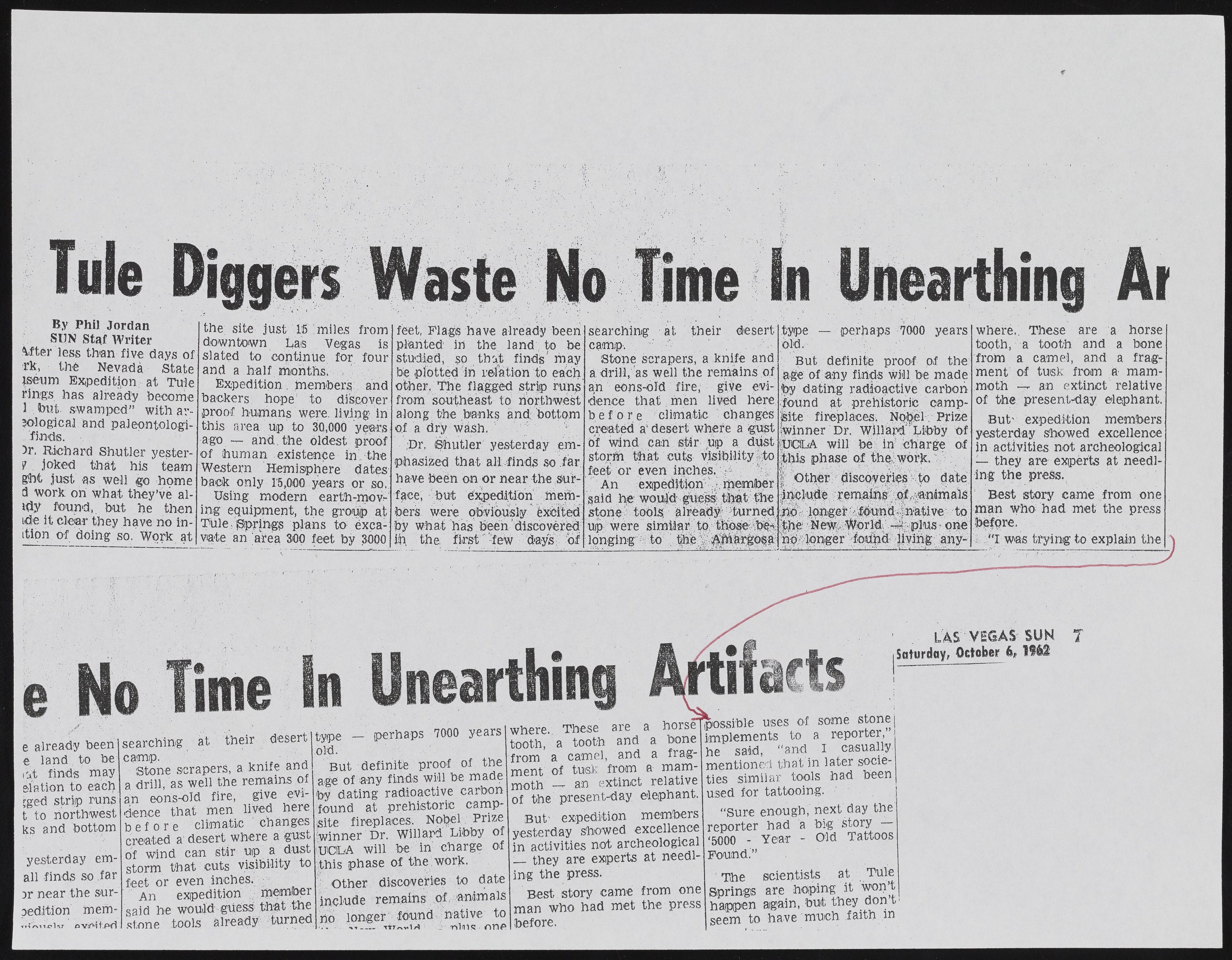Copyright & Fair-use Agreement
UNLV Special Collections provides copies of materials to facilitate private study, scholarship, or research. Material not in the public domain may be used according to fair use of copyrighted materials as defined by copyright law. Please cite us.
Please note that UNLV may not own the copyright to these materials and cannot provide permission to publish or distribute materials when UNLV is not the copyright holder. The user is solely responsible for determining the copyright status of materials and obtaining permission to use material from the copyright holder and for determining whether any permissions relating to any other rights are necessary for the intended use, and for obtaining all required permissions beyond that allowed by fair use.
Read more about our reproduction and use policy.
I agree.Information
Digital ID
Permalink
Details
More Info
Rights
Digital Provenance
Publisher
Transcription
By Phil Jordan SUN Staf Writer After less than five days of the' Nevada State iseum Expedition at Tule rings has already become 1 hut- swamped” with ar- ?ological and paleontologi- 'finds. >r. Richard Shu tier y ester-. 9 joked that his team glht just as well go home d work oh what they've ah M$y found,, but he then ide it clear they have no ini ition o f doing so. Work at the site just 16;miles from downtown has Vegas is slated to continue for. four and a ha 1 f months. 5j | Expedition, members and backers hope to discover proof humans were, living in this area, up to 30,000 years ago — and. the oldest proof of human existence in. the Western Hemisphere dates back only f5,000 years or so. Using modern earth-mowing equipment, the group at Tule Springs plans to exca| vate an area 300 feet by 3000 feet, Flags have already been planted in the land to be studied, so that finds' hi ay be plotted in relation to each other, The flagged strip runs from southeast to northwest along the banks and, bottom of a dry wash. : ' | | Dr, Shutler yesterday emphasized that all finds so far have been on or near the surface, but expedition members were obviously fexcited by what has been discovered in. the. first -few days of searching at their desert camp. ly 'ff gd Stone scrapers, a knife and a drill, as well the remains of an eons-old fire, give evidence that men lived here b e f o re climatic ch anges created a' desert where a gust of wind can stir pip a ddst storhi that cuts visibility|to feet or even inches. • An expedition iheimlber said | stone todl^ aitead^ gtorned^ longing to ' type — perhaps 7000 years bid. . But definite proof of the age of any finds will be made by dating radioactive carbon found at prehistoric campsite fireplaces, Nobel Prize ^winner Dr. willand' Dibby of iUOLA will be in charge of |id s phase' of the; work. p ; f Other discoveries to date, thbiudg nd/ longbr "todhd-Jiyihg; anywhere,. These are a horse tooth, a tooth, and a bone from a camel, and a fragment of tusk from a mammoth w" an extinct relative of the present-day elephant. But' expedition members yesterday showed excellence in activities not archeological — they are experts at needling the press. Best story came from one man who had met the press before. i “I was trying to explain the Soturdciyjr e already been e land to be finds may elation to each rged strip runs t to northwest ks and bottom yesterday email finds so .far ?r near the sur-pedition mem-tti /M i.d ir o Vip'l f.p O searching at their desert camp, , Stone scrapers, a knne and a drill, as well the remains of an eons-old fire, \ give evidence that men lived here b e f o r e climatic changes created a desert where a gust of wind can stir up a dust storm that cuts visibility to feet or even inches. An expedition member said he would guess that the stone tools already turned type — jperhaps 7000 ye ars old. But definite proof of the Hige of any finds will be m ade by d atin g radioactive carbon found at prehistoric campsite fireplaces. Nobel . Prize winner Dr. W illani Libby of UCLA will be in charge of this phase of the work. Other discoveries to date Include remains of. animals no longer found native to ' * m "l T T t r rvv« i i r v l i i i s n T V P where. These are a horse tooth, a tooth and a bone from a camel, and a fragment of tusk from a mammoth t an extinct relative of the present-day elephant. But' expedition members yesterday showed excellence in activities not archeological __they are experts at needling the press. Best story came from one man who had met the press before. possible uses of some stone implements to a reporter,” he said, “ and I casually mentioned th a t in later societies similar tools had been used for tattooing. j ‘Sure enough, next day the reporter had a big story DO - Year - Old Tattoos Found.” The scientists at Tule Springs are hoping it won’t happen again, but they don t seem to have much faith in

